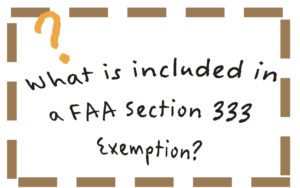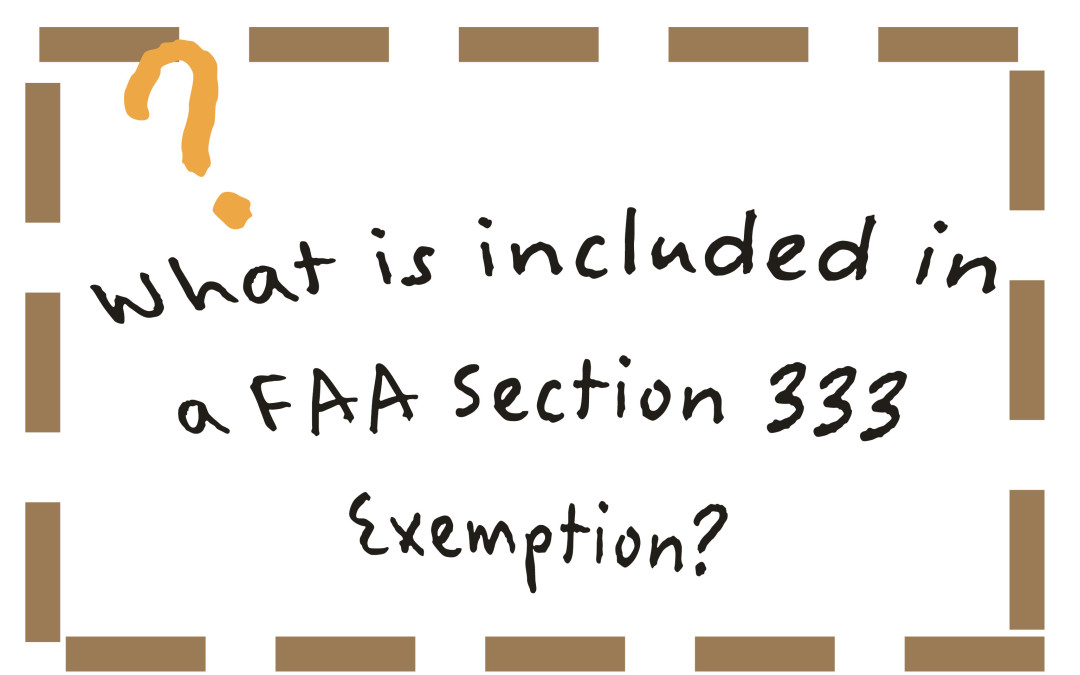What is a FAA Section 333 Exemption for drone use?
Great news! The FAA granted your Section 333 petition for exemption. You are ready to fly your drone for business and start making money. You are committed to flying your UAV legally and safely,in compliance with all FAA drone regulations. You have your comprehensive general liability drone insurance. You have provided new aerial photography and videography customers your Section 333 Exemption Number. You have added your customers as an additional insured to your drone insurance policy. Your customers love your professionalism and detailed safe-flight operations manuals. And you are ready to take the most amazing aerial shots with your DJI Phantom 3 Professional the world has ever seen.
You must comply with the FAA’s UAS Regulations and Limitations under the 333 Exemption
What many people fail to understand is that a 333 exemption does not give you permission to fly wherever, wherever or however you want. The exemption granted by the FAA likely has the following limitations built in. And you still need to comply with all federal aviation regulations under FAR/AIM. Before jumping into the FAA’s 333 petition process, make sure you know what you are getting. Here is a list of the list of requirements the drone operator / section 333 exemption holder will likely have to comply with as part of our day-to-day drone business.
Sample FAA 333 exemption limitations & conditions.

Obtaining a 333 exemption does not allow you to do whatever you want with a drone. There are still imitations, which are included in the FAA exemption, and all other federal aviation regulations still apply.
Here are some sample limitations you should expect to see in your exemption.
Section 333 Conditions and Limitations Imposed by the FAA:
In this grant of exemption, [name of operator] is hereafter referred to as the operator.
Failure to comply with any of the conditions and limitations of this grant of exemption will be grounds for the immediate suspension or rescission of this exemption.
- Operations authorized by this grant of exemption are limited to the [ Quadcopter mfg; model] when weighing less than 55 pounds including payload. Proposed operations of any other aircraft will require a new petition or a petition to amend this exemption.
- Operations for the purpose of closed-set motion picture and television filming are not permitted.
- The UA may not be operated at a speed exceeding 87 knots (100 miles per hour). The exemption holder may use either groundspeed or calibrated airspeed to determine compliance with the 87 knot speed restriction. In no case will the UA be operated at airspeeds greater than the maximum UA operating airspeed recommended by the aircraft manufacturer.
- The UA must be operated at an altitude of no more than 400 feet above ground level (AGL). Altitude must be reported in feet AGL.
- The UA must be operated within visual line of sight (VLOS) of the PIC at all times. This requires the PIC to be able to use human vision unaided by any device other than corrective lenses, as specified on the PIC’s FAA-issued airman medical certificate or U.S. driver’s license.
- All operations must utilize a visual observer (VO). The UA must be operated within the visual line of sight (VLOS) of the PIC and VO at all times. The VO may be used to satisfy the VLOS requirement as long as the PIC always maintains VLOS capability. The VO and PIC must be able to communicate verbally at all times; electronic messaging or texting is not permitted during flight operations. The PIC must be designated before the flight and cannot transfer his or her designation for the duration of the flight. The PIC must ensure that the VO can perform the duties required of the VO.
- This exemption and all documents needed to operate the UAS and conduct its operations in accordance with the conditions and limitations stated in this grant of exemption, are hereinafter referred to as the operating documents. The operating documents must be accessible during UAS operations and made available to the Administrator upon request. If a discrepancy exists between the conditions and limitations in this exemption and the procedures outlined in the operating documents, the conditions and limitations herein take precedence and must be followed. Otherwise,
 the operator must follow the procedures as outlined in its operating documents. The operator may update or revise its operating documents. It is the operator’s responsibility to track such revisions and present updated and revised documents to the Administrator or any law enforcement official upon request. The operator must also present updated and revised documents if it petitions for extension or amendment to this grant of exemption. If the operator determines that any update or revision would affect the basis upon which the FAA granted this exemption, then, the operator must petition for an amendment to its grant of exemption. The FAA’s UAS Integration Office (AFS···SO) may be contacted if questions arise regarding updates or revisions to the operating documents.
the operator must follow the procedures as outlined in its operating documents. The operator may update or revise its operating documents. It is the operator’s responsibility to track such revisions and present updated and revised documents to the Administrator or any law enforcement official upon request. The operator must also present updated and revised documents if it petitions for extension or amendment to this grant of exemption. If the operator determines that any update or revision would affect the basis upon which the FAA granted this exemption, then, the operator must petition for an amendment to its grant of exemption. The FAA’s UAS Integration Office (AFS···SO) may be contacted if questions arise regarding updates or revisions to the operating documents.
- Any UAS that has undergone maintenance or alterations that affect the UAS operation or flight characteristics e.g., replacement of a flight critical component, must undergo a functional test flight prior to conducting further operations under this exemption. Functional test flights may only be conducted by a PIC with a VO and must remain at least 500 feet from other people. The functional test flight must be conducted in such a manner so as to not pose an undue hazard to persons and property.
- The operator is responsible for maintaining and inspecting the UAS to ensure that is in a condition for safe operation.
- Prior to each flight, the PIC must conduct a pre-flight inspection and determine the UAS is in a condition for safe flight. The pre-flight inspection must account for all potential discrepancies, e.g., inoperable components, items, or equipment. If the inspection reveals a condition that affects the safe operation of the UAS, the aircraft is prohibited from operating until the necessary maintenance has been performed and the UAS is found to be in a condition for safe flight.
- The operator must follow the UAS manufacturer’s maintenance, overhaul, replacement, inspection, and life limit requirements for the aircraft and aircraft components.
- Each UAS operated under this exemption must comply with all manufacturer safety bulletins.
- Under this grant of exemption, a PIC must hold either an airline transport. commercial, private, recreational, or sport pilot certificate. The PIC must also hold a current FAA airman medical certificate or a valid U.S. driver’s license issued by a state, the District of Columbia, Puerto Rico, a territory, a possession, or the Federal government. The PIC must also meet the flight review requirements specified in 14 CFR § 61.56 in an aircraft in which the PIC is rated on his or her pilot certificate.
- The operator may not permit any PIC to operate unless the PIC demonstrates the ability to safely operate the UAS in a manner consistent with how the UAS will be operated under this exemption, including evasive and emergency maneuvers and maintaining appropriate distances from persons, vessels, vehicles and structures. PIC qualification flight hours and currency must be logged in a manner consistent with 14 CFR § 61.5l(b). Flights for the purposes of training the operator’s P Cs and VOs (training, proficiency, and experience-building) and determining the PIC’s ability to safely operate the UAS in a manner consistent with how the UAS will be operated under this exemption are permitted under the terms of this exemption. However, training operations may only be conducted during dedicated training sessions. During training, proficiency, and experience building flights, all persons not essential for flight operations are considered nonparticipants, and the PIC must operate the UA with appropriate distance from nonparticipants in accordance with 14 CFR § 91.119.
- UAS operations may not be conducted during nigh as defined in 14 CFR § I. All operations must be conducted under visual meteorological conditions (VMC). Flights under special visual flight rules (SVFR) are not authorized.
- The UA may not operate within 5 nautical miles of an airport reference point (ARP) as denoted in the current FAA Airport/Facility Directory (AFD) or for airports not denoted with an ARP, the center of the airport symbol as denoted on the current FAA-published aeronautical chart; unless a letter of agreement with that airport’s management is obtained or otherwise permitted by a COA issued to the exemption holder. The letter of agreement with the airport management must be made available to the Administrator or any law enforcement official upon request.
- The UA may not be operated less than 500 feet below or less than 2,000 feet horizontally from a cloud or when visibility is less than 3 statute miles from the PlC.
- If the UAS loses communications or loses its GPS signal, the UA must return to a pre-determined location within the private or controlled-access property.
- The PIC must abort the flight in the event of unpredicted obstacles or emergencies.
- The PIC is prohibited from beginning a flight unless (considering wind and forecast weather conditions) there is enough available power for the UA to conduct the intended operation and to operate after that for at least five minutes or with the reserve power recommended by the manufacturer if greater.
- Air Traffic Organization (ATO) Certificate of Waiver or Authorization (COA). All operations shall be conducted in accordance with an ATO-issued COA. The exemption holder may apply for a new or amended COA if it intends to conduct operations that cannot be conducted under the terms of the attached COA.
- All aircraft operated in accordance with this exemption must be identified by serial number, registered in accordance with 14 CPR part 47, and have identification (N-Number) markings in accordance with 14 CFR part 45, Subpart C. Markings must be as large as practicable.
- Documents used by the operator to ensure the safe operation and flight of the UAS and any documents required under 14 CFR §§ 91.9 and 91.203 must be available to the PIC at the Ground Control Station of the UAS any time the aircraft is operating. These documents must be made available to the Administrator or any law enforcement official upon request.
- The UA must remain clear and give way to all manned aviation operations and activities at all times.
- The UAS may not be operated by the PIC from any moving device or vehicle.
- All Flight operations must be conducted at least 500 feet from all nonparticipating persons, vessels, vehicles, and structures unless:
a. Barriers or structures are present that sufficiently protect nonparticipating persons from the UA and/or debris in the event of an accident. The operator must ensure that nonparticipating persons remain under such protection. If a situation arises where nonparticipating persons leave such protection and are within 500 feet of the UA, flight operations must cease immediately in a manner ensuring the safety of nonparticipating persons; and
b. The owner/controller of any vessels, vehicles or structures has granted permission for operating closer to those objects and the PIC has made a safety assessment of the risk of operating closer to those objects and determined that it does not present an undue hazard.
The PIC, VO, operator trainees or essential persons are not considered nonparticipating persons under this exemption.
- All operations shall be conducted over private or controlled access property with permission from the property owner/controller or authorized representative. Permission from property owner/controller or authorized representative will be obtained for each flight to be conducted.
- Any incident, accident, or flight operation that transgresses the lateral or vertical boundaries of the operational area as defined by the applicable COA must be reported to the FAA’s UAS Integration Office (AFS-80) within 24 hours. Accidents must be reported to the National Transportation Safety Board (NTSB) per instructions contained on the NTSB Web site: ntsb.gov.
If this exemption permits operations for the purpose of closed-set motion picture and television filming and production, the following additional conditions and limitations apply.
- The operator must have a motion picture and television operations manual (MPTOM) as documented in this grant of exemption.
- At least 3 days before aerial filming, the operator of the UAS affected by this exemption must submit a written Plan of Activities to the local Flight Standards District Office (FSDO) with jurisdiction over the area of proposed filming. The 3-day notification may be waived with the concurrence of the FSDO. The plan of activities must include at least the following:
a. Dales and times for all flights;
b. Name and phone number of the operator for the UAS aerial filming conducted under this grant of exemption;
c. Name and phone number of the person responsible for the on-scene operation of the UAS;
d. Make, model, and serial or N-Number of UAS to be used;
e. Name and certificate number of UAS PICs involved in the aerial filming;
f. A statement that the operator has obtained permission from property owners and/or local officials to conduct the filming production event; the list of those who gave permission must be made available to the inspector upon request;
g. Signature of exemption holder or representative; and
h. A description of the flight activity, including maps or diagrams of any area, city, town, county, and/or state over which filming will be conducted and the altitudes essential to accomplish the operation.
- Flight operations may be conducted closer than 500 feet from participating persons consenting to be involved and necessary for the filming production as specified in the exemption holder’s MPTOM.
Unless otherwise specified in this grant of exemption, the UAS, the UAS PIC, and the UAS operations must comply with all applicable parts of 14 CFR including, but not limited to, parts 45, 47, 61, and 91.

